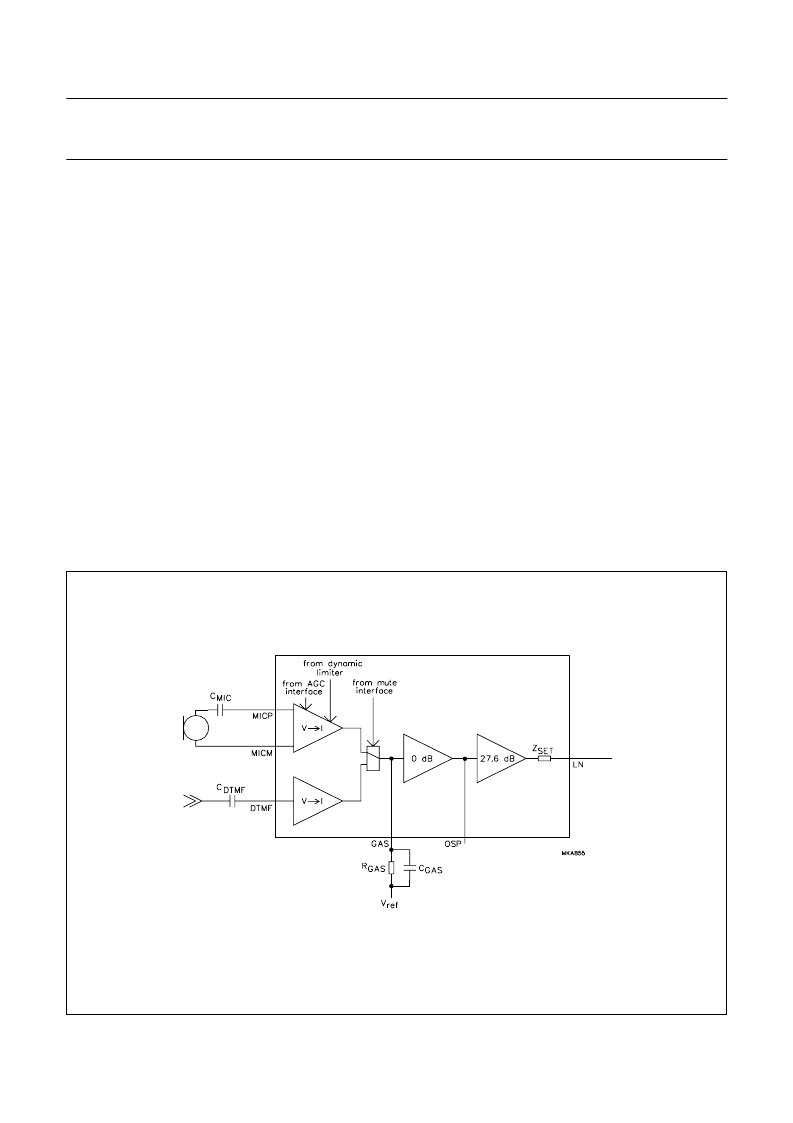- 您現(xiàn)在的位置:買賣IC網(wǎng) > PDF目錄383943 > TEA1096T (NXP SEMICONDUCTORS) Speech and listening-in IC PDF資料下載
參數(shù)資料
| 型號: | TEA1096T |
| 廠商: | NXP SEMICONDUCTORS |
| 元件分類: | 無繩電話/電話 |
| 英文描述: | Speech and listening-in IC |
| 中文描述: | TELEPHONE SPEECH CKT, PDSO28 |
| 封裝: | PLASTIC, SO-28 |
| 文件頁數(shù): | 9/32頁 |
| 文件大小: | 390K |
| 代理商: | TEA1096T |
第1頁第2頁第3頁第4頁第5頁第6頁第7頁第8頁當(dāng)前第9頁第10頁第11頁第12頁第13頁第14頁第15頁第16頁第17頁第18頁第19頁第20頁第21頁第22頁第23頁第24頁第25頁第26頁第27頁第28頁第29頁第30頁第31頁第32頁

November 1994
9
Philips Semiconductors
Product Specification
Speech and listening-in IC
TEA1096; TEA1096A
The function of the current switch TR1-TR2 is to reduce
distortion of large line signals. Current I
SUP
is supplied to
V
BB
via TR1, when V
SLPE
is higher than V
BB
+ 0.4 V. When
V
SLPE
is lower, this current is shunted to V
EE
via TR2. All
excess line current, not used for internal supply is
consumed in the V
BB
stabilizer or directly shunted to V
EE
.
To reduce the current consumption during pulse dialling,
the TEA1096/TEA1096A are provided with a power-down
(PD) input. The PD input has a pull-down structure. When
the voltage on PD is HIGH, the current consumption from
V
DD
capacitor C
VDD
is 100
μ
A and from the V
BB
supply
point 350
μ
A. The capacitors C
VDD
(100
μ
F) and C
VBB
(470
μ
F) are sufficient to power theTEA1096/TEA1096A
during pulse dialling/flash.
V
BB
voltage adjustment: pin VBA (TEA1096 only)
A resistor connected between pins VBA and V
EE
can be
used to increase the V
BB
voltage, whereas a resistor
connected between pins VBA and V
BB
will decrease the
V
BB
voltage. When adjusting the V
BB
voltage to a higher
value, care should be taken that V
SLPE
is at least 0.4 V
higher than V
BB
(V
BB
supply efficiency).
Sending channel: pins MICP, MICM, DTMF, GAS, OSP,
LN, MUTE, DLS and AGC
The TEA1096/TEA1096A has symmetrical microphone
inputs MICP, MICM with an input resistance of 64 k
between MICP and MICM (2
×
32 k
). In the speech mode
(MUTE = LOW), the overall gain from MICP-MICM to LN
can be adjusted from 33 dB to 52 dB to suit specific
requirements. The gain is proportional to the value of R
GAS
and equals 52 dB with R
GAS
= 90.9 k
and I
line
= 20 mA. A
capacitor C
GAS
connected in parallel with R
GAS
can be
used to provide a first-order low-pass filter.
Automatic gain control (AGC) is provided for line-loss
compensation as well as dynamic limitation for reduction
of the distortion of the transmitted signal on the line. The
microphone amplifier can be disabled by short-circuiting
pin DLS to V
EE
(secret function) and can be muted into
DTMF mode by applying a HIGH level on pin MUTE.
The TEA1096/TEA1096A has an asymmetrical DTMF
input with an input resistance of 20 k
. In the DTMF mode,
the overall gain from DTMF to LN is proportional to R
GAS
,
and is 26.5 dB less than the microphone amplifier gain.
Switch-over from one mode to the other is click-free.
Fig.6 Sending channel.
相關(guān)PDF資料 |
PDF描述 |
|---|---|
| TEA1098A | Speech and handsfree IC |
| TEA1098AH | Speech and handsfree IC |
| TEA1098ATV | Speech and handsfree IC |
| TEA1507 | GreenChipII SMPS control IC |
| TEA1507P | GreenChipII SMPS control IC |
相關(guān)代理商/技術(shù)參數(shù) |
參數(shù)描述 |
|---|---|
| TEA1096TD-T | 制造商:未知廠家 制造商全稱:未知廠家 功能描述:Telephone Speech Circuit |
| TEA1097 | 制造商:PHILIPS 制造商全稱:NXP Semiconductors 功能描述:Speech and loudspeaker amplifier IC with auxiliary inputs/outputs and analog multiplexer |
| TEA1097H | 制造商:PHILIPS 制造商全稱:NXP Semiconductors 功能描述:Speech and loudspeaker amplifier IC with auxiliary inputs/outputs and analog multiplexer |
| TEA1097TV | 制造商:PHILIPS 制造商全稱:NXP Semiconductors 功能描述:Speech and loudspeaker amplifier IC with auxiliary inputs/outputs and analog multiplexer |
| TEA1098 | 制造商:PHILIPS 制造商全稱:NXP Semiconductors 功能描述:Speech and handsfree IC |
發(fā)布緊急采購,3分鐘左右您將得到回復(fù)。